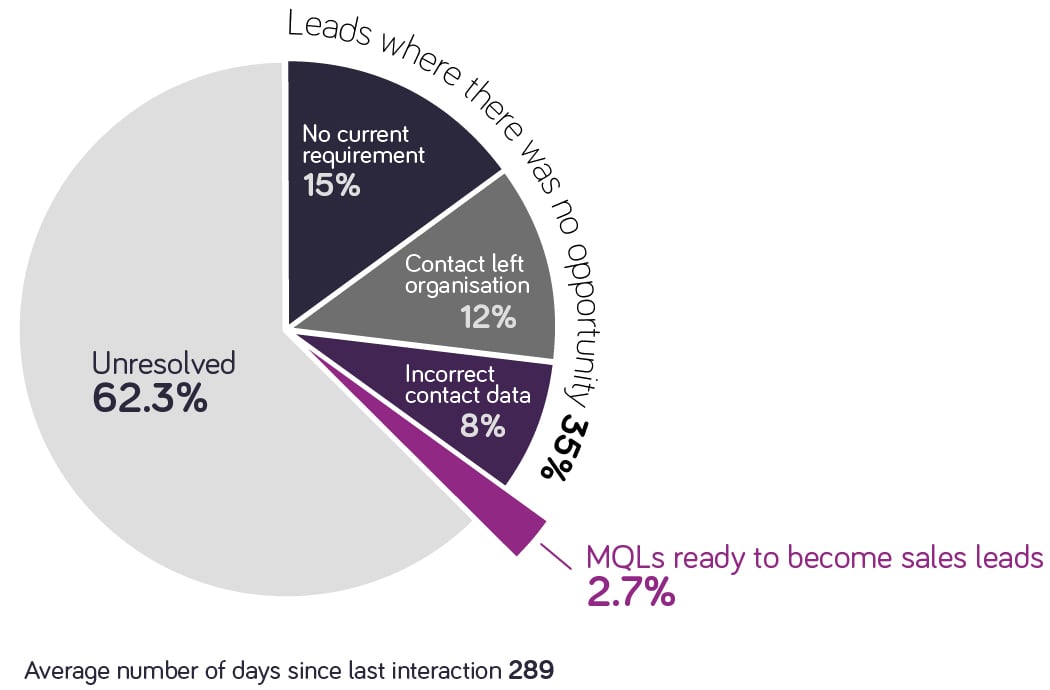Marketing qualified leads (MQLs) are losing credibility. That’s largely because, too often, they simply don’t convert into sales. As I’ve heard one CEO observe: “When is a lead not a lead? When it’s a marketing qualified lead.”
And they make a good point. Organisations are generating thousands of MQLs, but only a fraction of those reach the sales pipeline – and even fewer lead to closed deals. We’ve seen percentages as low as 0.5% of MQLS being accepted by sales.

Think about what this means:
-
It shows an alarming lack of results in an area where marketing should be having a big impact – results that should be supporting the business case for marketing automation, content marketing and inbound programmes.
-
Marketers are spending their budget on ‘leads’ that go nowhere.
-
It’s damaging Marketing’s reputation with the Sales team – for every lead that makes it into the pipeline, Sales has to review another 99 dead-ends.
To learn why so many MQLs don’t convert, we did some analysis, looking at 2,970 ‘cold’ MQLs over a two-month period. Here’s what we found:

Are MQLs really the right goal?
In truth, MQLs are a means to an end (generating revenue) – they shouldn’t be the end goal. But, as is so often the case, what gets measured, gets done. So marketing teams that are measured on the number of MQLs they generate will dedicate scarce time, resource and budget to hitting that number – even when they’re conscious of other, valuable things they could be doing to help the business achieve its strategic goals.
If the goal is to get more people to register for a download or hit a marketing automation score, so they can be tagged as MQLs, then marketing activities will be geared towards that, rather than focusing on converting leads into sales.
Of course, there are plenty of marketers who understand that MQLs aren’t a useful metric, but they can’t rely on pipeline or revenue reporting as measurements of marketing success. Attribution can be a major issue for marketers, and it’s not always easy to see what happens to prospects who achieve MQL status. Are Sales teams quick to follow up on the leads? And do you stop marketing to them once they’re an MQL?
So what’s the solution? In my experience, there are four practical things marketers can do to tackle the MQL trap:
1. Check whether Sales needs the leads
Marketing teams may have a clear idea of overall sales targets, but have they investigated the targets of individual salespeople and teams – and their plans for how they’ll meet these targets?
You need to determine if there’s a defined space in Sales teams’ plans that they expect to fill with leads from Marketing. If there isn’t, then your MQLs (and even your SQLs) won’t actually be needed. The best salespeople may be planning to bypass Marketing to hit their targets, relying on a combination of existing contact, referrals and self-generated leads.
For example, a few years ago we worked on a campaign for a really exciting new proposition where the client was leading the market. The problem was, the Sales team was only bonused on selling the new proposition if they also hit their targets for selling core existing products, so Sales and Marketing were left with conflicting priorities.
If you know your MQLs aren’t needed, then you can invest your time and budget in more useful activities – or work with the Sales teams to increase their targets based on the leads you’ll send them.
2. Don’t target MQLs, target pipeline or revenue
To get this right, you need to clearly define your ideal prospect profile, narrow down the target audience as much as possible, and maybe even monitor or predict organisations and contacts that appear to be the best targets.
You’ll need to work closely with Sales to agree on all this, and avoid the scenario all marketers have seen: you proudly hand over a lead to Sales, only to be told the company is currently an unhappy customer in dispute with your organisation.
Another important thing to consider is continuing marketing after the MQL stage. In fact, it’s often worth increasing marketing at this point to help improve conversion rates.
3. Sell the value of the next step, not the product
One of the biggest sticking points of converting an MQL into a closed deal is getting the contact to take a sales meeting.
So the first task is to understand – from the prospect’s point of view – what a great first sales meeting looks like. What should get covered? What format should it take? What benefit do they get from giving up an hour of their time?
If you can frame an initial sales meeting as a consultation or workshop that offers value to the prospect, your chances of success are much higher. Build the latter stages of your campaign to sell the value of this collaborative meeting, hinting at the insights they’ll get that they can take to the next board meeting. An offer of an interactive, collaborative workshop feels valuable and exciting, and like something they’d naturally find time for in their working day.
This approach also helps improve the MQL follow-up process. Rather than a call from a telemarketer weeks later, they get a face-to-face meeting to discuss the exciting new possibilities in detail.
4. Focus higher up the funnel
One of the main reasons marketers have focused on MQLs is that, traditionally, inbound enquiries from the website have been among the most valuable lead sources for sales.
These contacts were aware of the business, interested in what it had to offer and visited the website with the intention of getting in touch – so probably something like a third of those inbound enquiries converted into genuine sales opportunities. That led to setting high targets for web visitors, which led in turn to the counter-productive focus on MQLs we see today.
But instead of setting targets for these ‘instant MQLs’, marketers should look at what they were doing that meant those web visitors were such high-quality leads – things such as awareness-raising and brand-building that it’s easy to lose sight of in the rush for MQLs.




